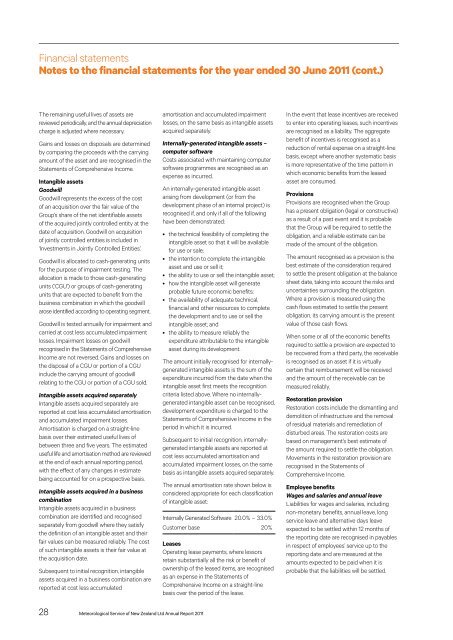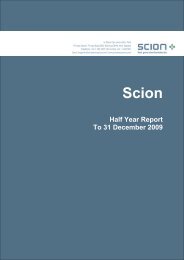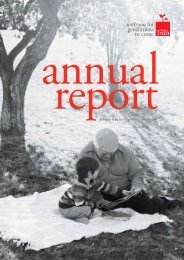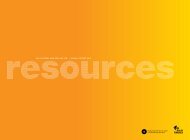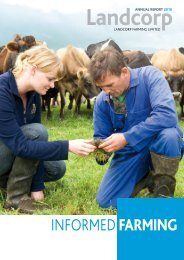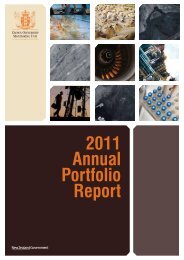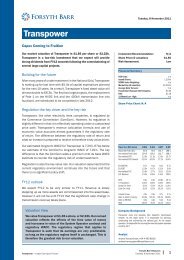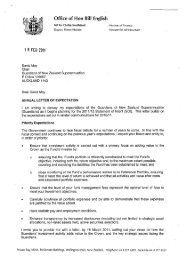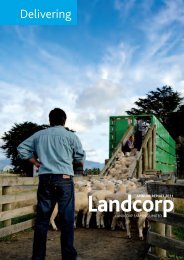MetService - Annual Report 2011 - Crown Ownership Monitoring Unit
MetService - Annual Report 2011 - Crown Ownership Monitoring Unit
MetService - Annual Report 2011 - Crown Ownership Monitoring Unit
Create successful ePaper yourself
Turn your PDF publications into a flip-book with our unique Google optimized e-Paper software.
Financial statements<br />
Notes to the financial statements for the year ended 30 June <strong>2011</strong> (cont.)<br />
The remaining useful lives of assets are<br />
reviewed periodically, and the annual depreciation<br />
charge is adjusted where necessary.<br />
Gains and losses on disposals are determined<br />
by comparing the proceeds with the carrying<br />
amount of the asset and are recognised in the<br />
Statements of Comprehensive Income.<br />
Intangible assets<br />
Goodwill<br />
Goodwill represents the excess of the cost<br />
of an acquisition over the fair value of the<br />
Group’s share of the net identifiable assets<br />
of the acquired jointly controlled entity at the<br />
date of acquisition. Goodwill on acquisition<br />
of jointly controlled entities is included in<br />
‘Investments in Jointly Controlled Entities’.<br />
Goodwill is allocated to cash-generating units<br />
for the purpose of impairment testing. The<br />
allocation is made to those cash-generating<br />
units (‘CGU’) or groups of cash-generating<br />
units that are expected to benefit from the<br />
business combination in which the goodwill<br />
arose identified according to operating segment.<br />
Goodwill is tested annually for impairment and<br />
carried at cost less accumulated impairment<br />
losses. Impairment losses on goodwill<br />
recognised in the Statements of Comprehensive<br />
Income are not reversed. Gains and losses on<br />
the disposal of a CGU or portion of a CGU<br />
include the carrying amount of goodwill<br />
relating to the CGU or portion of a CGU sold.<br />
Intangible assets acquired separately<br />
Intangible assets acquired separately are<br />
reported at cost less accumulated amortisation<br />
and accumulated impairment losses.<br />
Amortisation is charged on a straight-line<br />
basis over their estimated useful lives of<br />
between three and five years. The estimated<br />
useful life and amortisation method are reviewed<br />
at the end of each annual reporting period,<br />
with the effect of any changes in estimate<br />
being accounted for on a prospective basis.<br />
Intangible assets acquired in a business<br />
combination<br />
Intangible assets acquired in a business<br />
combination are identified and recognised<br />
separately from goodwill where they satisfy<br />
the definition of an intangible asset and their<br />
fair values can be measured reliably. The cost<br />
of such intangible assets is their fair value at<br />
the acquisition date.<br />
Subsequent to initial recognition, intangible<br />
assets acquired in a business combination are<br />
reported at cost less accumulated<br />
amortisation and accumulated impairment<br />
losses, on the same basis as intangible assets<br />
acquired separately.<br />
Internally-generated intangible assets –<br />
computer software<br />
Costs associated with maintaining computer<br />
software programmes are recognised as an<br />
expense as incurred.<br />
An internally-generated intangible asset<br />
arising from development (or from the<br />
development phase of an internal project) is<br />
recognised if, and only if all of the following<br />
have been demonstrated:<br />
• the technical feasibility of completing the<br />
intangible asset so that it will be available<br />
for use or sale;<br />
• the intention to complete the intangible<br />
asset and use or sell it;<br />
• the ability to use or sell the intangible asset;<br />
• how the intangible asset will generate<br />
probable future economic benefits;<br />
• the availability of adequate technical,<br />
financial and other resources to complete<br />
the development and to use or sell the<br />
intangible asset; and<br />
• the ability to measure reliably the<br />
expenditure attributable to the intangible<br />
asset during its development.<br />
The amount initially recognised for internallygenerated<br />
intangible assets is the sum of the<br />
expenditure incurred from the date when the<br />
intangible asset first meets the recognition<br />
criteria listed above. Where no internallygenerated<br />
intangible asset can be recognised,<br />
development expenditure is charged to the<br />
Statements of Comprehensive Income in the<br />
period in which it is incurred.<br />
Subsequent to initial recognition, internallygenerated<br />
intangible assets are reported at<br />
cost less accumulated amortisation and<br />
accumulated impairment losses, on the same<br />
basis as intangible assets acquired separately.<br />
The annual amortisation rate shown below is<br />
considered appropriate for each classification<br />
of intangible asset:<br />
Internally Generated Software 20.0% – 33.0%<br />
Customer base 20%<br />
Leases<br />
Operating lease payments, where lessors<br />
retain substantially all the risk or benefit of<br />
ownership of the leased items, are recognised<br />
as an expense in the Statements of<br />
Comprehensive Income on a straight-line<br />
basis over the period of the lease.<br />
In the event that lease incentives are received<br />
to enter into operating leases, such incentives<br />
are recognised as a liability. The aggregate<br />
benefit of incentives is recognised as a<br />
reduction of rental expense on a straight-line<br />
basis, except where another systematic basis<br />
is more representative of the time pattern in<br />
which economic benefits from the leased<br />
asset are consumed.<br />
Provisions<br />
Provisions are recognised when the Group<br />
has a present obligation (legal or constructive)<br />
as a result of a past event and it is probable<br />
that the Group will be required to settle the<br />
obligation, and a reliable estimate can be<br />
made of the amount of the obligation.<br />
The amount recognised as a provision is the<br />
best estimate of the consideration required<br />
to settle the present obligation at the balance<br />
sheet date, taking into account the risks and<br />
uncertainties surrounding the obligation.<br />
Where a provision is measured using the<br />
cash flows estimated to settle the present<br />
obligation, its carrying amount is the present<br />
value of those cash flows.<br />
When some or all of the economic benefits<br />
required to settle a provision are expected to<br />
be recovered from a third party, the receivable<br />
is recognised as an asset if it is virtually<br />
certain that reimbursement will be received<br />
and the amount of the receivable can be<br />
measured reliably.<br />
Restoration provision<br />
Restoration costs include the dismantling and<br />
demolition of infrastructure and the removal<br />
of residual materials and remediation of<br />
disturbed areas. The restoration costs are<br />
based on management’s best estimate of<br />
the amount required to settle the obligation.<br />
Movements in the restoration provision are<br />
recognised in the Statements of<br />
Comprehensive Income.<br />
Employee benefits<br />
Wages and salaries and annual leave<br />
Liabilities for wages and salaries, including<br />
non-monetary benefits, annual leave, long<br />
service leave and alternative days leave<br />
expected to be settled within 12 months of<br />
the reporting date are recognised in payables<br />
in respect of employees’ service up to the<br />
reporting date and are measured at the<br />
amounts expected to be paid when it is<br />
probable that the liabilities will be settled.<br />
28 Meteorological Service of New Zealand Ltd <strong>Annual</strong> <strong>Report</strong> <strong>2011</strong>


